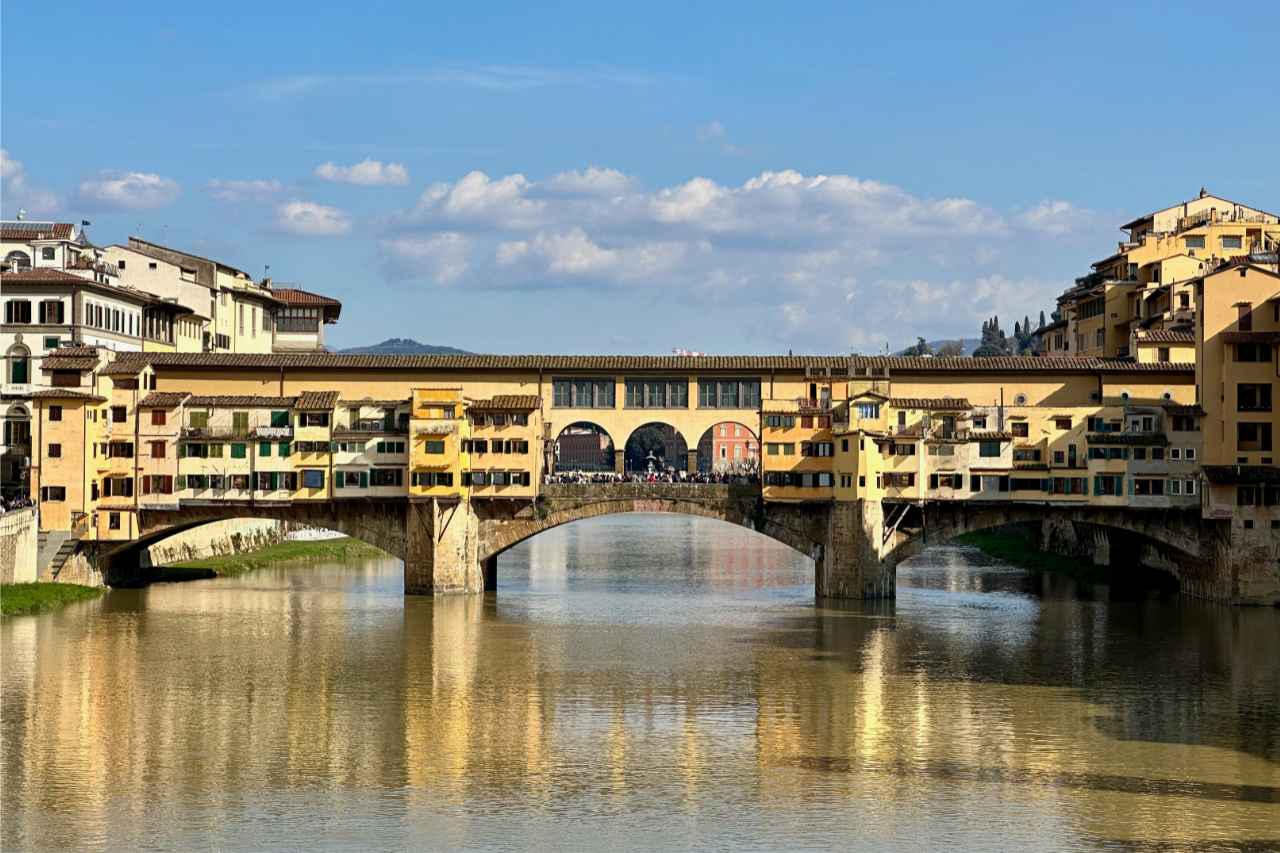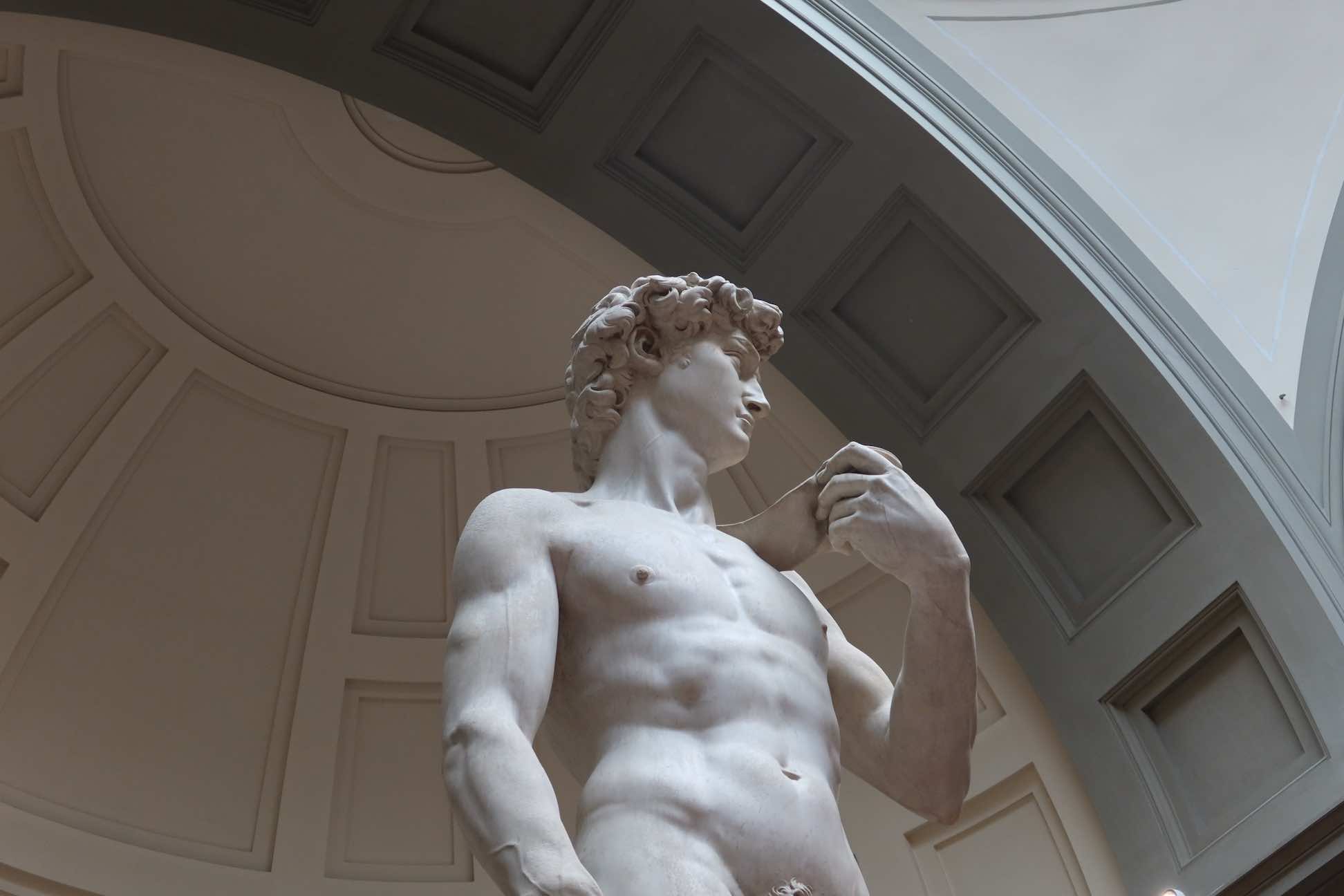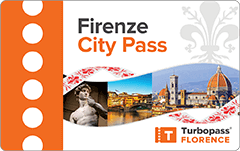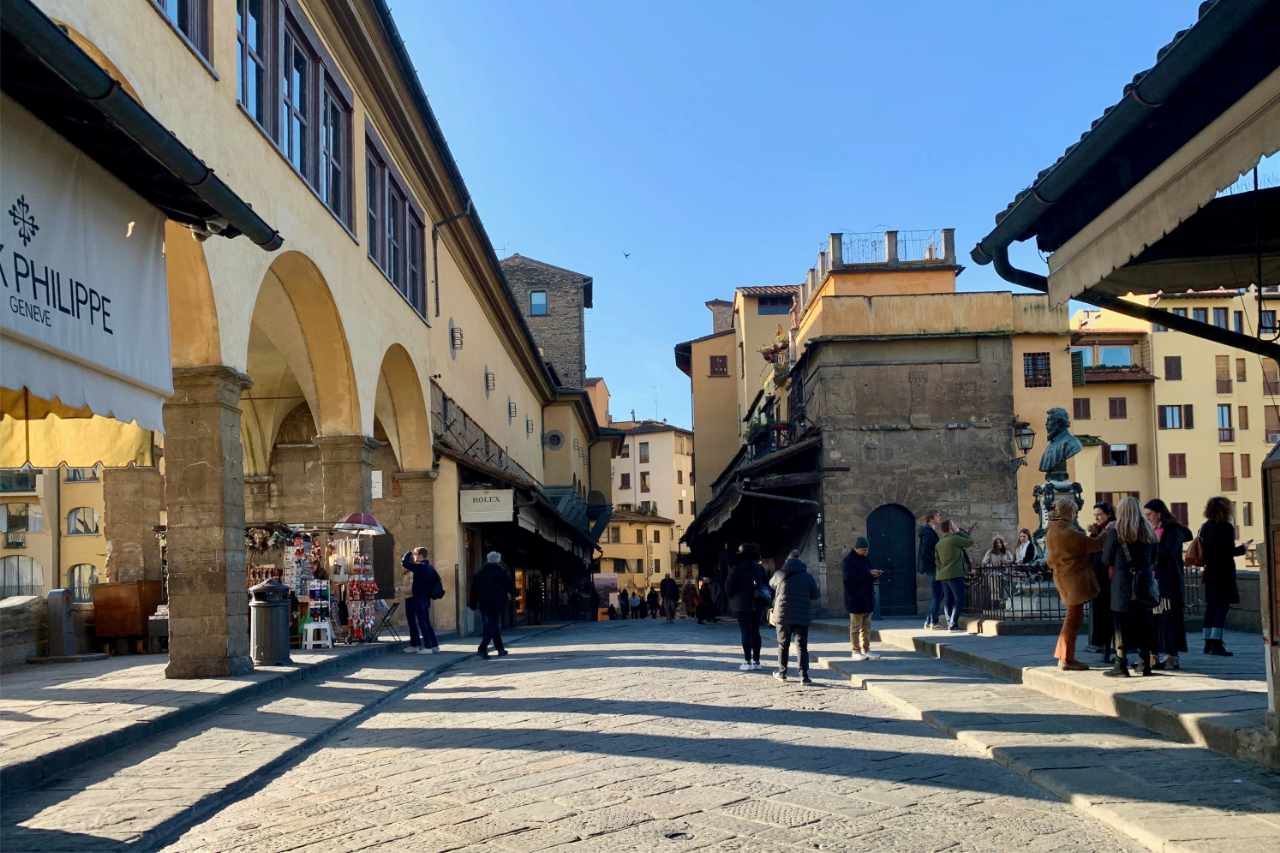- Sign up & get a FREE ebook Subscribe Today!
- Florencewise Home Page
- What to do in florence
- ponte vecchio
Discover the Ponte Vecchio bridge in Florence
The Ponte Vecchio (‘old bridge’) over the Arno River is one of Florence’s most famous and most historically important landmarks.
 Whatever angle you see the Ponte Vecchio from, it's magnificent! Keep reading to find out more about it
Whatever angle you see the Ponte Vecchio from, it's magnificent! Keep reading to find out more about itFind out why it’s so important to Florentines and why tourists love to visit.
Ponte Vecchio Florence - Everything you need to know
The Ponte Vecchio is the most famous bridge in Florence.
And, being the oldest bridge in Florence it's much more than just a beautiful bridge, but rather a historically important landmark and a monument.
 You'll be able to admire the bridge from many spots in Florence, including from the Uffizi Gallery windows
You'll be able to admire the bridge from many spots in Florence, including from the Uffizi Gallery windowsRead on to discover what makes the Ponte Vecchio special, and why locals and visitors love it so much.
On this page, we'll be exploring:
- The history of the Ponte Vecchio
- The Vasari Corridor
- What to see on and near the Ponte Vecchio
- The shopping options on the Ponte Vecchio
- Practical information about visiting the Ponte Vecchio
A brief history of the Ponte Vecchio bridge in Florence
Located on the narrowest point of the Arno River, the Romans constructed a bridge where their famous Via Cassia crossed the Arno.
 When you look out from the Ponte Vecchio, you can see why this spot was chosen for crossing the river Arno
When you look out from the Ponte Vecchio, you can see why this spot was chosen for crossing the river ArnoWe have to go back well into the Middle Ages to find the oldest document that mentions the bridge in 996 AD.
Not always called 'old bridge', until 1218 the Ponte Vecchio was in fact the only bridge in Florence.
When the Ponte alla Carraia (or Ponte Nuovo) was built, Ponte Vecchio became the 'old bridge'.
The history of the Ponte Vecchio
The Romans had built stone piers carrying a wooden structure to cross the Arno River.
That wooden structure lasted well into the Middle Ages, when it was destroyed in a flood.
The bridge was rebuilt in stone but got swept away again two centuries later, to get rebuilt in 1345.
In the sixteenth century the famous biographer of artists and architects, Giorgio Vasari, mentions Taddeo Gaddi as the architect.
According to modern historians, it might have been another Italian artist, Neri di Fioravanti, who built the bridge that has been standing ever since.
Built originally as a part of Florence's defence system, the shops (that you'll now find on the entire bridge) were added later.
Check out our top tips for making the most of your time in Florence:
The Vasari Corridor
It's hard to find a monument in Florence that was built or altered without the Medici family being involved.
In 1565 Cosimo de Medici commissioned biographer and architect Giorgio Vasari to build him a secret passageway that connected Palazzo Pitti and Palazzo Vecchio.
The idea was that he and his family would be able to easily travel between their two residences without any member of the public seeing them.
Today, the Vasari Corridor is part of the Uffizi Gallery.
As of 2016 it was closed for major renovations, but as of December 2024 it is open once more - check out our full guide here for all the details you need!
As a citizen of late medieval Florence, you would have found butchers, fishmongers and tanners on the bridge.
You can imagine the smells from the fishmongers and the waste created by the tanners not being pleasant at all!
The Medici's decided only goldsmiths and jewellers should be allowed to have shops on the bridge, and this has held true even to today.
The Modern History of the Ponte Vecchio
After World War II, the fleeing Germans destroyed every bridge in Florence.
The Ponte Vecchio was the only bridge in Florence that survived World War II, because rather than blow up the bridge, the Nazis demolished the buildings on either side, blocking access to the bridge so no one could cross.
In 1966 the Arno River burst its banks again and it looked like the bridge could be destroyed as it had been back in the 13th century.
But, built of stone, and much stronger now, Ponte Vecchio survived this dramatic flood, despite an incredible gush of water hitting it with great force.
No matter what season you visit Florence, here are 4 things never to leave at home:
Disclosure: If you make a purchase through a link on this page, I may receive a small commission - at no extra cost to you. Thank you for supporting my site!
What to see on and near the Ponte Vecchio
The jewellery stores along the bridge are a big draw for tourists.
Many of them can be quite expensive and more reasonably priced jewellery stores can be found in other parts of Florence.
In the centre of the bridge, look up at the rooftops and you’ll see the ancient sundial that marked the rebuilding of this bridge in stone following the devastating flood.
The inscription on the sundial, commemorating the building of the stone bridge is still there, but difficult to make out now.
Ponte Vecchio is a charming and romantic bridge for a stroll, and just a short distance away from other amazing monuments, churches and squares.
On the south bank of the River Arno, you'll find the impressive Pitti palace, the Boboli Gardens and the austere Santo Spirito Church.
A twenty-minute walk up to Piazzale Michelangelo will reward you with fabulous views.
You can see all over Florence from this vantage point.
Even closer, on the opposite side of the bridge is Piazza della Signoria, a large square where locals meet daily and where tourists gather to watch Florentine life go by.
A true open-air gallery, but no part of it more so than the Loggia dei Lanzi.
Grand arches welcome you inside this open-air art museum, where you can see sculptures and statues, including Perseus with the head of Medusa, for free.
 The bust of Benvenuto Cellini, who created some of the sculptures in the Loggia dei Lanzi, is in the center of the bridge
The bust of Benvenuto Cellini, who created some of the sculptures in the Loggia dei Lanzi, is in the center of the bridgeShopping on the Ponte Vecchio
As ordered by Ferdinand the First, most shops on Ponte Vecchio are jewellers.
Some of these jewellery stores are still owned and run by direct descendants of those original jewellers.
There are dedicated watch stores here too, and some antiques and souvenirs, but you won’t find any leather goods or any other kinds of shops on the bridge itself.
On the banks of the bridge, in the district of Oltrarno, you’ll find a wider selection of shops that cater to a wider budget.
🤙 Roaming in Italy? 📱
Get yourself an Italian eSIM for calls, messages and data when traveling here.
Save on data charges with plans from just 19€ from Holafly - our recommended eSIM provider - click here to find out more.
Other shopping options near the Ponte Vecchio
In the centre of the city, the Via de’ Tournabuoni has made a name for itself as the fashion district of Florence.
It’s proved so popular with visitors, the area has expanded and continues to expand and now you can shop for Gucci, Prada and Armani on these famous streets.
If that’s a little out of your budget, the open-air market is a great place to bag a bargain.
Just be careful who you are buying from in this part of town, as there are pavement sellers in this area trying to offload replica goods.
How to visit the Ponte Vecchio
You can visit the bridge at any time of day, as it doesn’t close and is accessible 24 hours a day.
You’re free to walk over the bridge at any time, but vehicles are not allowed.
Experience all that Florence has to offer with this immersive tour that takes you around the city as well as inside some of Florence's top sights!
How to reach the Ponte Vecchio
If you’re arriving in Florence by train, it takes just 15 minutes to walk from Santa Maria Novella Station to Ponte Vecchio.
It’s a pretty straight walking route, passing the Basilica di Santa Maria Novella, onto Piazza Strozzi, and along the river bank until you reach the bridge.
If you’re already in the city and have arrived by other means, it takes ten minutes to walk to Ponte Vecchio from Piazza del Duomo and only three minutes from Piazza della Signoria.
The best time to visit
Ponte Vecchio is a must-visit while you’re in Florence, but if you want to enjoy it in peace before the crowds arrive, head over at 8 AM when you’ll have it mostly to yourself.
It’s also a lovely place for a wander in the evening.
The shops close at around 8PM, but there are people around enjoying the bridge till midnight and there’s a lovely atmosphere when the sun goes down.
Florencewise's Top Travel Resources
Ready to book your trip to Florence? Take a look at these helpful links to companies we use and trust:
- Keep your travel spending simple with the Wise card, which removes all the worry about exchange rates and high transaction fees all over the world
- Search for and book your perfect accommodation
- Our complete guide to what to pack for Florence
- The number one travel accessory, a multi-point travel adapter and voltage converter
- Browse a huge range of tours in Florence and beyond
- Experience unique tours and special access to Florence's most popular sights
- Protect yourself with comprehensive travel insurance
Within this post there are some affiliate links for products and services. For more details about our affiliate policy click here.
Receive the latest Florence news, travel tips, insights and more!
Simply sign-up today for our free newsletter:
We are committed to respecting your data. Click for our Privacy Policy.
Comments? Questions? Suggestions?
Please come over to the private Facebook group and join in the conversation.
You will often find me there, happy to answer your questions / comments!
You will also meet other Florence lovers and experts, too.
What are you waiting for?
























